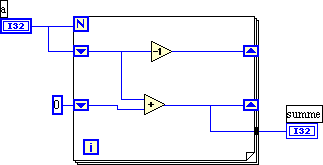|
|
|
|
int sum(int a) { int summe=0; for ( ;a;a--) summe+=a; return(summe); }
|
 |
Recording a spectrum with our present apparatus requires controlling
of a number of electronic devices as well as aquisitioning of different
types of measuring data. A well-known development tool for realizing
such an instrument control system is the program development system LabVIEW,
which is based on the programming language "G".
Communication with GPIB or serial interfaces but also with data acquisition
devices is significantly made easier by LabVIEW.
In contrast to conventional text-based programming languages (like C, BASIC) G is a graphical programming language. The so-called block diagram is a pictorial solution to a given programming task and represents the source code of a program. Individual objects, which send or acquire data or execute special functions are tied together by wires, representing the flow of data. This concept is totally different from the sequential order in text-based languages.
In the following example the source code of a simple C function is compared
to the equivalent block diagram in LabVIEW. A value > 0 is passed
to the function sum which then
returns the sum of all numbers from 1 to the specified value.
For example, when passing the number 5 to the function the value 15 will
be returned (1+2+3+4+5=15).
|
|
|
|
int sum(int a) { int summe=0; for ( ;a;a--) summe+=a; return(summe); }
|
 |
Several devices of our measuring system whose computer-based control
was realized by the development system LabVIEW are listed below:
Further information about LabVIEW:
